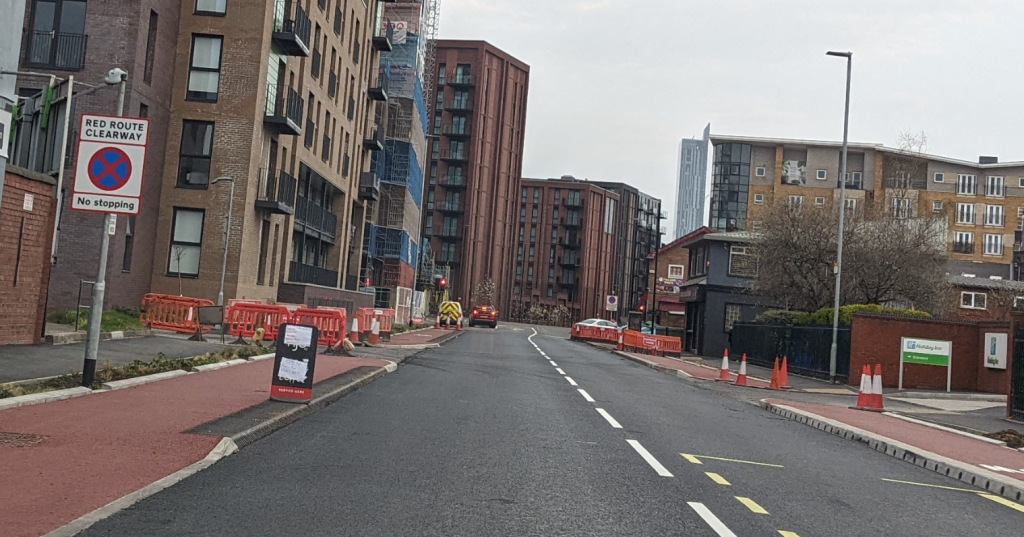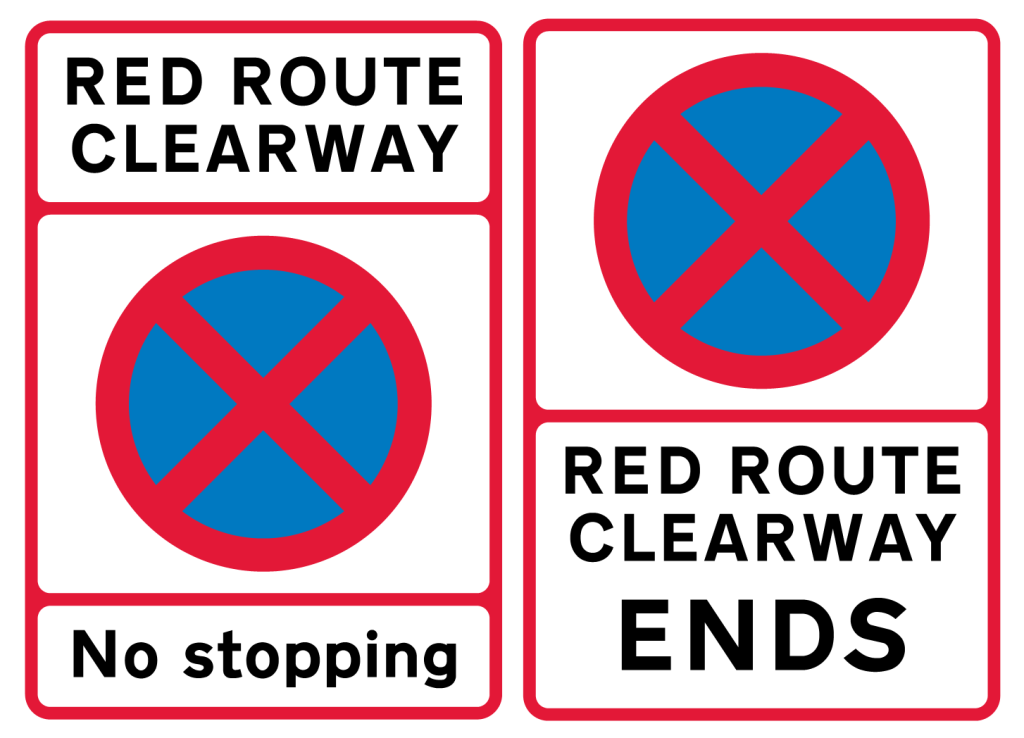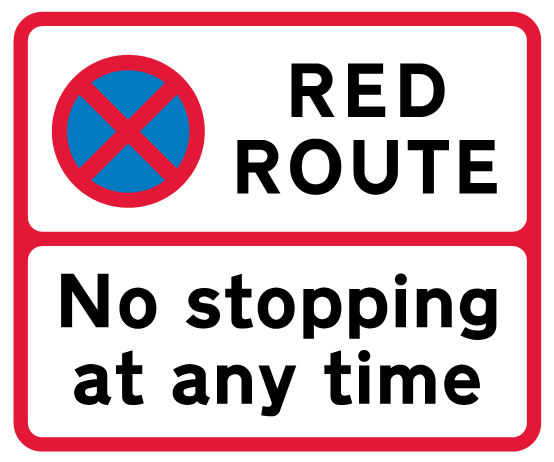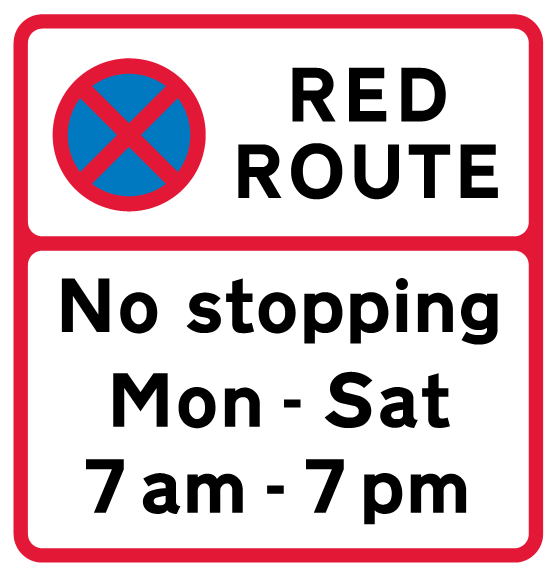The Liverpool Street cycleway in Salford is now almost complete. Others have commented on some of the, er, interesting design features of the junctions but this article isn’t going to cover that.
What has brought about some additional comment is the provision of Red Route Clearway signs. These are not a new innovation but Greater Manchester has been incredibly slow to adopt them whilst places adjacent (like Blackburn with Darwen of all places – https://showmeasign.online/2017/08/24/blackburn-sees-red/) have.

For those who did not know, and haven’t read the article linked above, Red Routes were first introduced in Greater London as an alternative to spending billions widening every major A-road as conventional wisdom at the time suggested. The idea was that most congestion in London was caused by foolishly parked vehicles that obstructed traffic lanes on what were still trunk roads at the time. Many of these were already “Urban Clearways” but the rules of these were not well understood and they often conflicted with existing yellow lines. The main difference between an urban clearway and a regular one was you can drop off and pick up passengers on them. Red Routes changed this to only blue badge holders and hackney carriages and some licensed private hires being allowed to do so. Anyone else stopping would face pretty much the full wrath of London’s traffic enforcement.
For many years, these markings remained unique to London – Edinburgh had a variation authorised by the Scottish government confusingly called Greenways (so called because of the bus lanes they supported being coloured in green) – but for England & Wales the DfT eventually softened their stance and would specially authorise their use elsewhere after the 2002 TSRGD came into effect. Very few places bothered though despite the Traffic Management Act 2004 making civil parking enforcement a viable method of enforcing them. That said, some experiments were undertaken in the West Midlands but generally it was not until the relaxation of the requirement to have approvals in 2016 that the provinces dared to try a bit more.
Greater Manchester, however, has never felt the need until quite recently having seen Manchester City Council trial a short red route with red lines on Wilbraham Road (it soon got removed again), and now Wigan Council and Salford City Council open new highway schemes as Red Route Clearways.
This is where we have an issue! Red Route Clearways are a beefier version of the standard ‘rural’ clearway. They lack road markings, and are not immediately obvious on urban streets. They are intended for urban dual carriageways and major bypass roads; indeed this happens in London, where the sub-motorway sections of the North Circular Road have Red Route Clearway status and the built-up 1930s sections with frontage development use red lines. The only guidance on the use of red routes is a couple of pages in TSM Chapter 3 and the general lack of understanding of the nuances of on-street parking management on display across much of the UK at present have seen some really problematic installations that won’t have any chance of successful enforcement if someone was to head off to the Traffic Penalty Tribunal.
So – to make life easier, here is a quick primer of what the different restrictions and sign types mean on red routes and how you know if one is workable.
Red Route Clearway
These are sign only restrictions – there should not be any lines associated with them. As said above they are intended for higher speed urban roads where parking is unlikely and exist purely to keep traffic moving. They only require “regular” repeaters as a result. Unlike traditional “rural” clearways which only apply to the carriageway, stopping anywhere within the highway boundary, even for pick up/set down, is prohibited except where specifically indicated – which in layman’s terms means bus stops are about the only exemption. They also by default stop footway parking which is why the Liverpool Street cycleway has them – it’s a sledgehammer to crack a nut.

Double Red Lines
These are the step below a full blown Red Route Clearway. The pick up/set down and blue badge exemptions apply but everyone else will be ticketed for stopping on red lines. These too apply to the entire highway, like yellow lines. It used to be the case that repeater signs were required but this is no longer the case so it is not possible to contest a Penalty Charge Notice for “not seeing the signs” – the lines alone are enough.

Single Red Lines
These allow stopping out of the prohibited hours and are generally seen as a compromise on roads where peak hour congestion is a concern but off-peak is less of an issue. This also usually keeps local shopkeepers on side when implementing a scheme, as it doesn’t prevent loading out of hours. This saves the need to provide specific bays although personally I’d rather kerbside management was a bit more prescriptive on major routes, especially where interactions with active travel routes exist.

Other Restrictions
Red parking bays had a restricted usage condition. This may be limited loading periods during the times of operation of a single red line but available as a parking space for anybody outside of these times for instance. These are covered in more detail in TSM Chapter 3. For contrast, white parking bays are general use and behave as any other parking bay would.
Conclusion
The Liverpool Street scheme is intended to prevent footway parking and loophole abuse along a new cycle route. The intent is understandable and laudable but given that Liverpool Street is not a high speed artery and does have direct frontage it is too overbearing a restriction that will generate ill-feeling from local residents and businesses as a result.
My recommendation is that the Red Route Clearway should be replaced with double red lines and permitted loading bays provided adjacent to businesses that require them. This also allows the setting down and picking up of passengers by taxis and licensed private hire vehicles which along with the blue badge exemption allows for compliance with the Equalities Act. As it currently stands the Red Route Clearway here could be argued to not represent a reasonable adjustment. I want the Liverpool Street cycle route to be safe and usable but equally I understand there is a need to maintain traffic management and an almost dogmatic blanket ban on stopping is not the appropriate way to achieve that. This also has the unfortunate side effect of pushing vehicle parking into side roads and the design of these where they interact with the cycle way is already questionable without additional vehicles obstructing these areas having been forced off Liverpool Street proper.
However, despite these technical foibles on the parking front, this scheme represents a vast improvement over the old dereliction that plagued Liverpool Street and future residential development that is enabled by this scheme will change the way the route serves Salford anyway over the coming few years.

One further advantage of red routes (both versions) is that they are one of the few restrictions exempt from Eric Pickles’ attempt to ban camera enforcement by introducing new regulations under the Deregulation Act. Camera enforcement is very useful in areas where cars are parked without being left completely unattended.
LikeLiked by 1 person
Absolutely – the narrative of “nasty councils bullying motorists” is very good at spreading not least thanks to the efforts of Eric Pickles a decade ago.
LikeLike
Can these be enforced e.g with footage from a bicycle camera sent to the council showing a van and clear company/reg plate stopped on the clearway on Liverpool st?
LikeLike